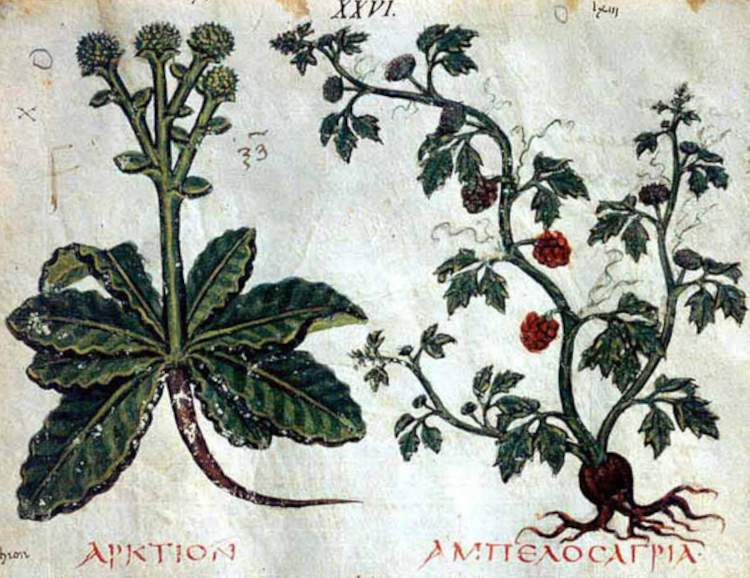The National Library of Naples opens an exhibition on illustrated medicine. A very rare herbarium on display
On Sunday, Dec. 4, the Vittorio Emanuele III National Library of Naples opens the monumental halls on the second floor to the public with free guided tours from 10 a.m. to 2 p.m. of both the sections and the book collections. Also opening on the same day will be the exhibition La medicina illustrata. Art and Science from the Middle Ages to the Early Modern Age manuscripts and printed books from the National Library of Naples, curated by director Maria Iannotti and Daniela Bacca, Teresa D’Urso, Claudia Grieco, Andrea Improta, and Sandra Perriccioli.
The famous Neapolitan Dioscorides, a very rare example of a late antique herbarium consisting of 170 hand-illustrated pages with more than four hundred plants, each depicted in detail in its roots, stem, leaves, flowers and fruits, will stand out. Also to be admired are the manuscripts of the Salerno School, which played a leading role in the development of medical studies throughout the Middle Ages, illustrated in the last thirty years of the 13th century: among them, Galen’s commentaries on the works of Hippocrates; Celsus’ De medicina, among the finest medical texts produced in Naples in the 15th century embellished with initials, friezes and frames, probably made for Ferrante of Aragon, duke of Calabria.
The exhibition is on view until Feb. 5, 2023, and aims to document the beginnings of medicine and its progressive development, highlighting the establishment since antiquity of a vision of human care aimed at maintaining good health: from welfare intervention to spa treatments and hygiene rules. Among the curiosities on display is the matriculation of the Neapolitan confraternity of theHospital of Santa Maria del Popolo degli Incurabili, one of the most important Neapolitan welfare institutions. At the beginning of the file, the coat of arms of Emperor Charles V, who was among the confraternity’s first governors, appears alongside those of Pope Leo X and the city of Naples. The therapeutic benefits of the Phlegrean area’s thermal waters are featured in the woodcuts illustrating the expanded edition of Pietro da Eboli’s De Balneis puteolanis and the Chronicle of Partenope, printed in Naples in 1507 and 1526, respectively. The exhibition allows visitors to grasp the development of artistic languages between the early Middle Ages and the modern age and at the same time documents the importance of book illustration in conveying health care.
"The exhibition offers an opportunity to measure the variety and importance of the Neapolitan library’s book heritage, which preserves editions of great value and uniqueness, such as the Neapolitan Dioscorides, a very rare Italian-made codex of the treatise on pharmacotherapeutics by Dioscorides of Anazarbo, who lived in the first century A.D., which is different from the other existing codices of Dioscorides," says National Library director Maria Iannotti. “The work also constitutes a fundamental source for the study of Greco-Roman medical culture and its reception in the Italian Byzantine world in the late 6th and early 7th centuries. The selection of incredibly beautiful illuminated manuscripts produced between the 6th and 16th centuries and of incunabula and cinquecentine documents how the illustrated book, whether manuscript or printed, was the main vehicle for the transmission of knowledge for centuries. Indeed, the very books on medical subjects demonstrate how medicine used illustration to develop a system of images that could help the reader better understand and memorize the text, giving rise to a specific iconographic tradition.”
Illustrations for scientific purposes was often entrusted to miniaturists, draughtsmen and engravers, sometimes of great artistic quality, who helped consolidate for herbaria an illustrative tradition of plants and fruits with a medicinal function; for medical treatises, on the other hand, of surgical instruments, anatomical depictions, and other interventions related to the treatment of diseases.
The exhibition is organized by the “Vittorio Emanuele III” National Library of Naples in collaboration with the Department of Humanities and Cultural Heritage of the University of Campania “Luigi Vanvitelli,” with the support of the University of Campania “Luigi Vanvitelli” and the Bracco Foundation of Milan.
 |
| The National Library of Naples opens an exhibition on illustrated medicine. A very rare herbarium on display |
Warning: the translation into English of the original Italian article was created using automatic tools. We undertake to review all articles, but we do not guarantee the total absence of inaccuracies in the translation due to the program. You can find the original by clicking on the ITA button. If you find any mistake,please contact us.





























